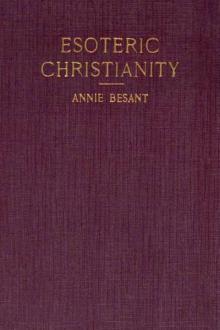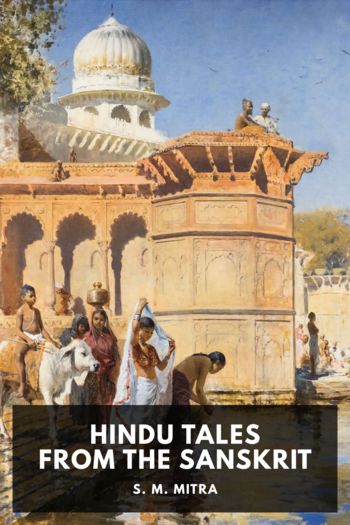Esoteric Christianity by Annie Besant (interesting books to read for teens .txt) 📕

Read free book «Esoteric Christianity by Annie Besant (interesting books to read for teens .txt) 📕» - read online or download for free at americanlibrarybooks.com
- Author: Annie Besant
- Performer: -
Read book online «Esoteric Christianity by Annie Besant (interesting books to read for teens .txt) 📕». Author - Annie Besant
The custom of Infant Baptism gradually grew up in the Church, and hence the instruction which in the early days preceded Baptism came to be the preparation for Confirmation, when the awakened mind and intelligence take up and re-affirm the baptismal promises. The reception of the infant into the Church is seen to be rightly done, when man's life is recognised as being lived in the three worlds, and when the Spirit and Soul who have come to inhabit the new-born body are known to be not unconscious and unintelligent, but conscious, intelligent, and potent in the invisible worlds. It is right and just that the "Hidden Man of the heart"[339] should be welcomed to the new stage of his pilgrimage, and that the most helpful influences should be brought to bear upon the vehicle in which he is to dwell, and which he has to mould to his service. If the eyes of men were opened, as were of old those of the servant of Elisha, they would still see the horses and chariots of fire gathered round the mountain where is the prophet of the Lord.[340]
We come to the second of the Sacraments selected for study, that of the Sacrifice of the Eucharist, a symbol of the eternal Sacrifice already explained, the daily sacrifice of the Church Catholic throughout the world imaging that eternal Sacrifice by which the worlds were made, and by which they are evermore sustained. It is to be daily offered, as its archetype is perpetually existent, and men in that act take part in the working of the Law of Sacrifice, identify themselves with it, recognise its binding nature, and voluntarily associate themselves with it in its working in the worlds; in such identification, to partake of the material part of the Sacrament is necessary, if the identification is to be complete, but many of the benefits may be shared, and the influence going forth to the worlds may be increased, by devout worshippers, who associate themselves mentally, but not physically, with the act.
This great function of Christian worship loses its force and meaning when it is regarded as nothing more than a mere commemoration of a past sacrifice, as a pictorial allegory without a deep ensouling truth, as a breaking of bread and a pouring out of wine without a sharing in the eternal Sacrifice. So to see it is to make it a mere shell, a dead picture instead of a living reality. "The cup of blessing which we bless, is it not the communion [the communication of, the sharing in] of the blood of Christ?" asks the apostle. "The bread which we break, is it not the communion of the body of Christ?"[341] And he goes on to point out that all who eat of a sacrifice become partakers of a common nature, and are joined into a single body, which is united to, shares the nature of, that Being who is, present in the sacrifice. A fact of the invisible world is here concerned, and he speaks with the authority of knowledge. Invisible Beings pour of their essence into the materials used in any sacramental rite, and those who partake of those materials—which become assimilated in the body and enter into its ingredients—are thereby united to those whose essence is in it, and they all share a common nature. This is true when we take even ordinary food from the hand of another—part of his nature, his vital magnetism, mingles with our own; how much more true then when the food has been solemnly and purposely impregnated with higher magnetisms, which affect the subtle bodies as well as the physical. If we would understand the meaning and use of the Eucharist we must realise these facts of the invisible worlds, and we must see in it a link between the earthly and the heavenly, as well as an act of the universal worship, a co-operation, an association, with the Law of Sacrifice, else it loses the greater part of its significance.
The employment of bread and wine as the materials for this Sacrament—like the use of water in the Sacrament of Baptism—is of very ancient and general usage. The Persians offered bread and wine to Mithra, and similar offerings were made in Tibet and Tartary. Jeremiah speaks of the cakes and the drink offered to the Queen of Heaven by the Jews in Egypt, they taking part in the Egyptian worship.[342] In Genesis we read that Melchisedek, the King-Initiate, used bread and wine in the blessing of Abraham.[343] In the various Greek Mysteries bread and wine were used, and Williamson mentions their use also among the Mexicans, Peruvians, and Druids.[344]
The bread stands as the general symbol for the food that builds up the body, and the wine as symbol of the blood, regarded as the life-fluid, "for the life of the flesh is in the blood."[345] Hence members of a family are said to share the same blood, and to be of the blood of a person is to be of his kin. Hence, also, the old ceremonies of the "blood-covenant"; when a stranger was made one of a family or of a tribe, some drops of blood from a member were transfused into his veins, or he drank them—usually mingled with water—and was thenceforth considered as being a born member of the family or tribe, as being of its blood. Similarly, in the Eucharist, the worshippers partake of the bread, symbolising the body, the nature, of the Christ, and of the wine symbolising the blood, the life of the Christ, and become of His kin, one with Him.
The Word of Power is the formula "This is My Body," "This is My Blood." This it is which works the change which we shall consider in a moment, and transforms the materials into vehicles of spiritual energies. The Sign of Power is the hand extended over the bread and the wine, and the Sign of the Cross should be made upon them, though this is not always done among Protestants. These are the outer essentials of the Sacrament of the Eucharist.
It is important to understand the change which takes place in this Sacrament, for it is more than the magnetisation previously explained, though this also is wrought. We have here a special instance of a general law.
By the occultist, a visible thing is regarded as the last, the physical, expression of an invisible truth. Everything is the physical expression of a thought. An object is but an idea externalised and densified. All the objects in the world are Divine ideas expressed in physical matter. That being so, the reality of the object does not lie in the outer form but in the inner life, in the idea that has shaped and moulded the matter into an expression of itself. In the higher worlds, the matter being very subtle and plastic, shapes itself very swiftly to the idea, and changes form as the thought changes. As matter becomes denser, heavier, it changes form less readily, more slowly, until, in the physical world, the changes are at their slowest in consequence of the resistance of the dense matter of which the physical world is composed. Let sufficient time be given, however, and even this heavy matter changes under the pressure of the ensouling idea, as may be seen by the graving on the face of the expressions of habitual thoughts and emotions.
This is the truth which underlies what is called the doctrine of Transubstantiation, so extraordinarily misunderstood by the ordinary Protestant. But such is the fate of occult truths when they are presented to the ignorant. The "substance" that is changed is the idea which makes a thing to be what it is; "bread" is not mere flour and water; the idea which governs the mixing, the manipulation, of the flour and water, that is the "substance" which makes it "bread," and the flour and the water are what are technically called the "accidents," the arrangements of matter that give form to the idea. With a different idea, or substance, flour and water would take a different form, as indeed they do when assimilated by the body. So also chemists have discovered that the same kind and the same number of chemical atoms may be arranged in different ways and thus become entirely different things in their properties, though the materials are unchanged; such "isomeric compounds" are among the most interesting of modern chemical discoveries; the arrangement of similar atoms under different ideas gives different bodies.
What, then, is this change of substance in the materials used in the Eucharist? The idea that makes the object has been changed; in their normal condition bread and wine are food-stuffs, expressive of the divine ideas of nutritive objects, objects fitted for the building up of bodies. The new idea is that of the Christ nature and life, fitted for the building up of the spiritual nature and life of man. That is the change of substance; the object remains unchanged in its "accidents," its physical material, but the subtle matter connected with it has changed under the pressure of the changed idea, and new properties are imparted by this change. They affect the subtle bodies of the participants, and attune them to the nature and life of the Christ. On the "worthiness" of the participant depends the extent to which he can be thus attuned.
The unworthy participant, subjected to the same process, is injuriously affected by it, for his nature, resisting the pressure, is bruised and rent by the forces to which it is unable to respond, as an object may be broken into pieces by vibrations which it is unable to reproduce.
The worthy partaker, then, becomes one with the Sacrifice, with the Christ, and so becomes at one with also, united to, the divine Life, which is the Father of the Christ. Inasmuch as the act of Sacrifice on the side of form is the yielding up of the life it separates from others to be part of the common Life, the offering of the separated channel to be a channel of the





Comments (0)